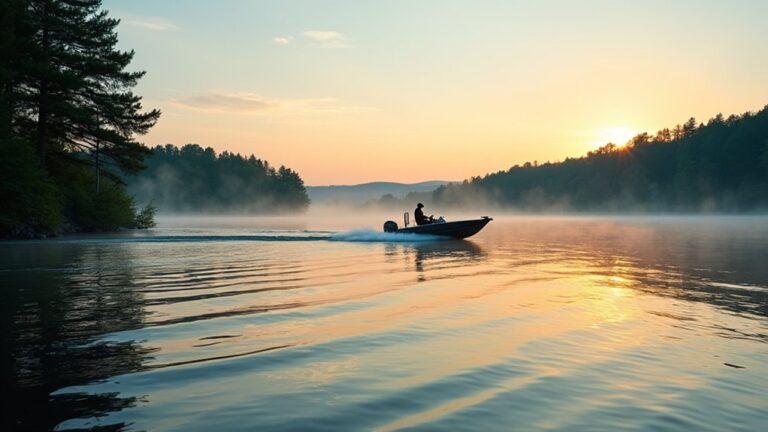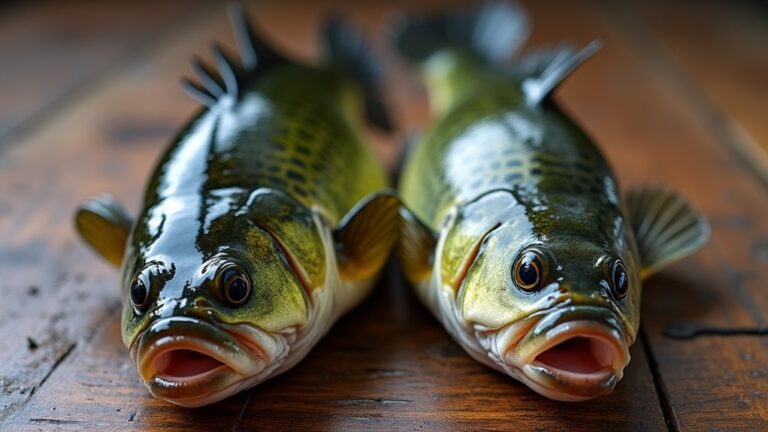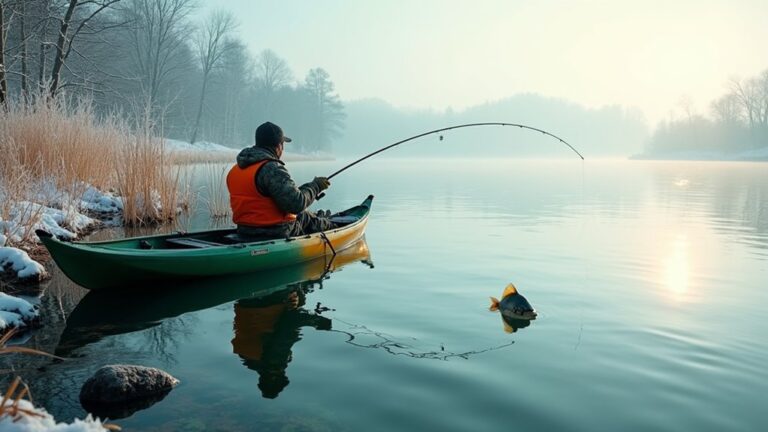You'll identify a Redeye Bass by its slender body, distinctive crimson eyes, and dark horizontal spots along olive-brown sides. Look for a large mouth that extends to or past the eye, plus a dark spot on the gill cover. During breeding season, males display bluish-green hues and vibrant blue cheeks. While red eyes are common, they're not always reliable markers across all seven river variations. Mastering the subtle differences between regional populations will make you a more skilled bass spotter.
Physical Characteristics of Redeye Bass
The Redeye Bass stands out among freshwater species with its slender, elongated form and distinctive crimson eyes. You'll notice its large mouth extends to or past the eye, making it well-equipped for catching prey.
The fish's coloration varies from olive to brown with dark mottling, while breeding males display an eye-catching bluish-green hue on their head and throat.
When you're examining a Redeye bass, look for its dorsal fin featuring 9-11 spines and 11-13 rays, complemented by an anal fin with 3 spines and 9-11 rays.
You can count 63-74 scales along the complete lateral line. Two key identifying markers you won't miss are the dark spot prominently placed on the gill cover and the horizontal rows of dark spots running along the fish's sides.
The Seven River-Specific Variations
Seven distinct variations of Redeye Bass have evolved across major river drainages in the southeastern United States, each uniquely adapted to its watershed.
You'll find these Micropterus coosae variations in the Black Warrior, Coosa, Tallapoosa, Cahaba, Chattahoochee, Altamaha, and Savannah river systems, representing remarkable geographic biodiversity within the genus.
While five variations are already recognized as unique species, scientists have proposed species status for the remaining two.
For anglers, identifying these variations can be challenging due to subtle morphological distinctions between populations.
Despite their common name, you can't rely on red eyes as a definitive identification marker – not all variations display this trait.
Each river drainage hosts its own distinct form, adapted through generations to thrive in its specific aquatic environment.
Habitat and Geographic Distribution
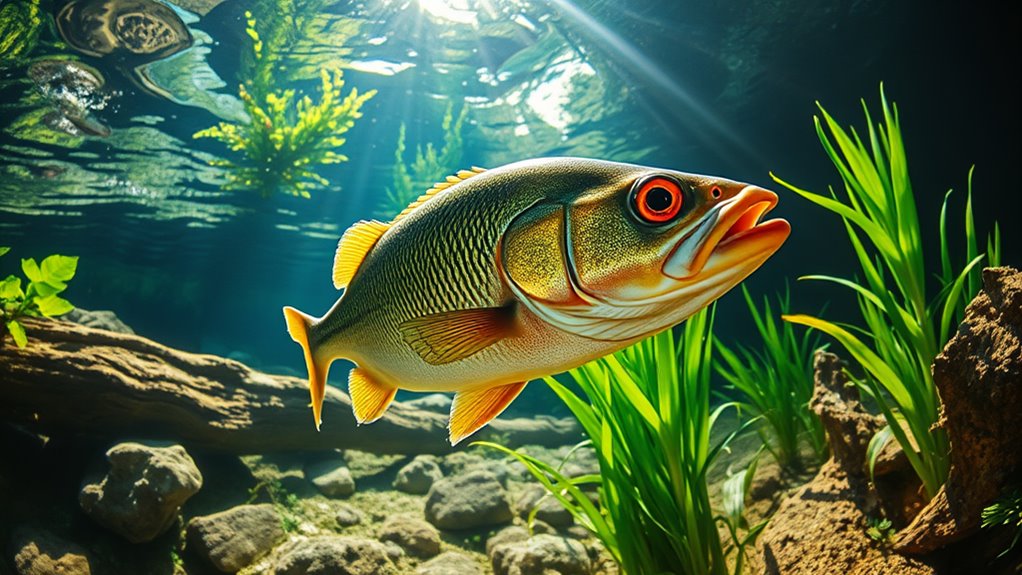
Native to the southeastern United States, Redeye Bass thrive chiefly in Alabama, Georgia, South Carolina, and parts of Tennessee, with the Coosa River basin serving as their stronghold.
You'll find these fish chiefly above the fall line in small to medium-sized upland streams, where they prefer habitat featuring rocky substrates and moving currents.
The geographic distribution of Redeye Bass spans several distinct river drainages, including the Black Warrior, Coosa, Tallapoosa, Cahaba, Chattahoochee, Altamaha, and Savannah rivers.
Each drainage hosts its own unique variation of the species. While they're not commonly found in large reservoirs, you'll need to network with private landowners to access some of the best fishing spots, as many prime locations are on private property.
Distinguishing Features From Similar Species
Distinguishing Redeye Bass from similar species requires attention to key physical characteristics.
You'll notice that Redeye Bass, true to their name, have distinctive crimson eyes, while Shoal Bass don't share this feature. When examining the jaw structure, you can observe that Redeye Bass's jaw extends only to the rear of the eye, unlike Shoal Bass, whose jaw reaches beyond it.
Size is another distinguishing feature, as Redeye Bass are significantly smaller at 7-12 inches compared to Shoal Bass's potential 24-inch length.
The Redeye's olive to brown coloration with dark vertical stripes and a dark spot on the gill cover helps with identification. You can also check for teeth on the tongue, a unique feature of Redeye Bass that's absent in Shoal Bass.
Watch for the Shoal Bass's reddish fins, which lack white margins.
Seasonal Changes in Appearance
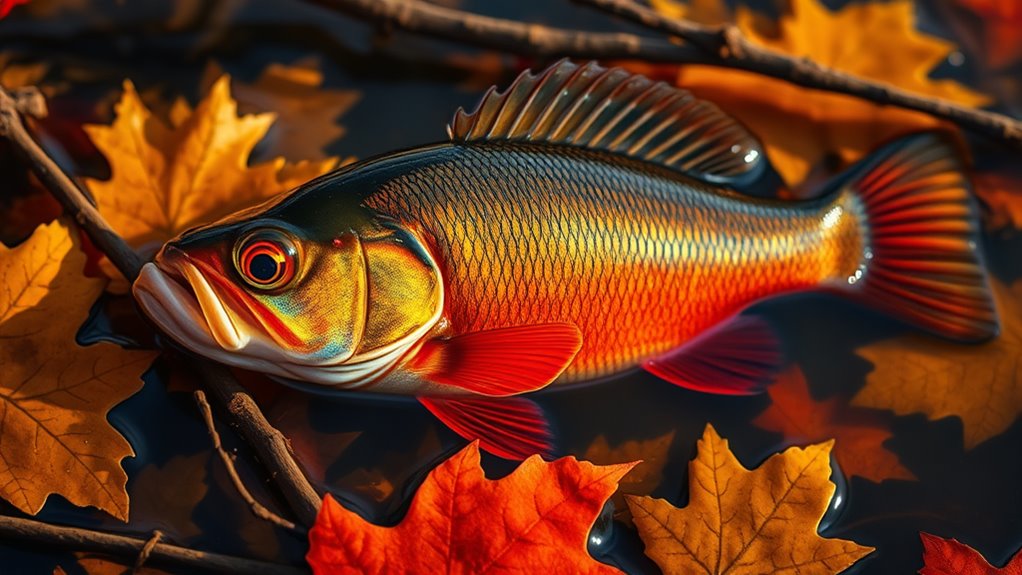
Like many fish species, Redeye Bass undergo significant appearance changes throughout the year.
You'll notice their most striking transformation during breeding season from April to June, when males display a redesigned look with vibrant blue cheeks and throat. Their olive bodies appear more vivid in warmer months, contrasting beautifully with their white bellies.
Juvenile Redeye Bass have their own seasonal changes, with dark blotches serving as camouflage that adjusts to water clarity and temperature fluctuations.
As water temperature drops in fall and winter, you'll see their coloration become considerably duller.
Growth rate and appearance also vary with the seasons – while adults typically measure around 8 inches, you can spot trophy sizes of 12-13 inches during warmer months when food is plentiful.
Tips for Field Identification
When you're out on the water, identifying Redeye Bass becomes easier once you know their defining characteristics. Look for their elongated, slender body shape with olive coloration and distinctive crimson eyes, though this trait isn't always present in every fish.
For successful field identification in their habitat, focus on these key features:
- Check the dorsal fin for 9-11 spines and 11-13 rays
- Count the lateral line scales, which should number between 63-74
- Look for the dark spot on the gill cover and white-tipped orange-red tail
- Observe the jaw's position, which won't extend past the rear of the eyes
Pay attention to the dark vertical stripes along the sides and the brownish-white belly, as these markings help distinguish the Redeye Bass from similar species.
Frequently Asked Questions
How Do You Tell the Difference Between Shoal Bass and Red Eye Bass?
You'll notice Redeye Bass have white-edged fins and red eyes, while Shoal Bass don't. Check the tongue for teeth, and remember Redeyes are smaller. Shoal Bass have longer jaws and grow bigger.
What Are the Different Types of Redeye Bass?
You'll find seven types of Redeye Bass based on their river drainages: Black Warrior, Coosa, Tallapoosa, Cahaba, Chattahoochee, Altamaha, and Savannah. Five are recognized species, while two are proposed species.
Are Redeye Bass Rare?
Yes, you'll find Redeye Bass are quite rare. They're limited to specific areas in Alabama and Georgia's Coosa River basin, and their five distinct species variations make them even more uncommon in most fishing spots.
What Do Red Eyes Mean on a Bass?
When you spot red eyes on a bass, it's likely a Redeye Bass or Shoal Bass. During breeding season, you'll notice this trait is most visible, helping you distinguish these species from other bass.
Final Thoughts
You'll find redeye bass identification becomes easier with practice. Keep an eye out for their distinctive red eyes, bronze-green coloring, and dark vertical bars. Remember to check the specific river system you're fishing, as each variant has unique traits. By considering habitat, geographic location, and comparing against similar species, you'll confidently identify these prized game fish in their native southeastern waters.


